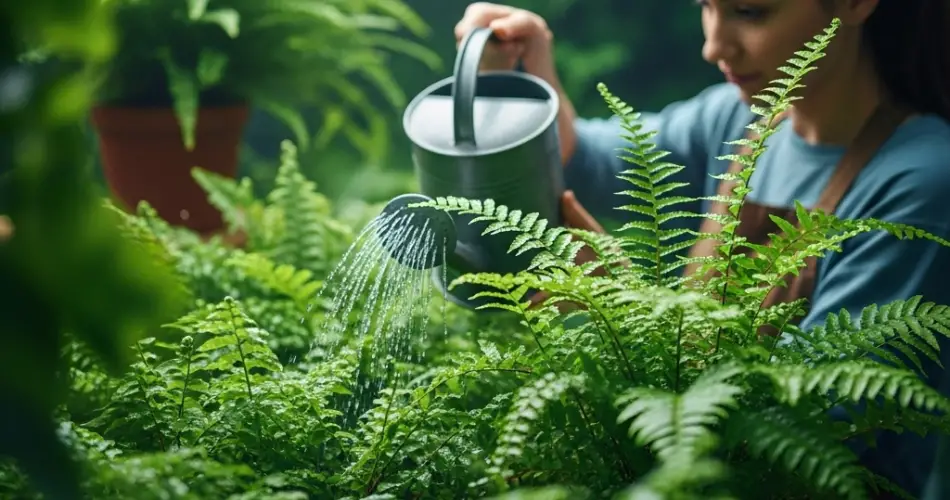Ferns are beloved for their lush, feathery foliage and their ability to thrive in shaded, humid environments. Whether displayed in pots, hanging baskets, or garden beds, ferns add a soft, natural beauty to any space. However, while they love moisture, ferns are also prone to root rot if the soil becomes too soggy. The key to healthy, thriving ferns lies in maintaining the perfect balance of moisture—keeping the soil consistently damp without overwatering.
If you’re struggling to find that balance, this guide will help you understand how to water your ferns effectively without drowning their roots.
Understanding Ferns’ Natural Environment
In their natural habitat, ferns grow on forest floors, under the canopy of trees where the air is humid and the soil stays moist due to regular rainfall and organic matter. However, this soil is also well-drained thanks to the loose structure of decomposed leaves and bark.
When growing ferns indoors or in containers, it’s important to replicate these conditions—moist but airy soil and high humidity. Overwatering in compact or poorly-draining soil can lead to waterlogged roots and fungal issues.
How Often Should You Water Ferns?
There’s no universal schedule for watering ferns. Instead, you should base your watering routine on environmental conditions and soil moisture. Generally, ferns prefer the soil to be consistently moist but not saturated.
-
Indoors: Water once every 3–5 days in warmer months and every 7–10 days in cooler seasons.
-
Outdoors: Frequency depends on weather. In warm, dry conditions, you may need to water daily; during rainy periods, watering might be unnecessary.
Always check the soil before watering. Stick your finger about an inch (2.5 cm) into the soil—if it feels dry at that depth, it’s time to water.
The Right Way to Water Ferns
-
Water Evenly and Slowly
Pour water gently around the base of the plant until it just begins to drain from the bottom of the pot. This ensures the root zone is thoroughly moistened without oversaturating the soil. -
Avoid Shallow Watering
Light surface watering doesn’t reach the roots. Deep watering encourages strong root development and better moisture retention. -
Allow Excess Water to Drain
After watering, make sure the pot drains freely. Never allow ferns to sit in standing water, as this quickly leads to soggy soil and root rot. -
Use Room-Temperature Water
Cold water can shock the plant, while hot water can damage roots. Always use water at room temperature.
Choosing the Right Soil and Pot
Proper soil and containers are just as important as watering habits.
-
Soil: Ferns need a light, well-draining potting mix that retains moisture without becoming compacted. A blend of peat moss, perlite, and pine bark or compost works well.
-
Pots: Always choose a pot with drainage holes. Terracotta pots allow moisture to evaporate more easily, reducing the risk of overwatering.
Avoid using heavy garden soil or moisture-retaining mixes meant for other houseplants, as these can hold too much water for ferns.
Signs of Overwatering
Ferns love moisture, but too much of a good thing can be harmful. Look for these signs of overwatering:
-
Yellowing or wilting leaves
-
Mushy or foul-smelling roots
-
Mold or fungus growing on the soil surface
-
Soil that remains wet for several days after watering
If overwatering is suspected, let the soil dry out before the next watering. In severe cases, repot the fern into fresh, dry soil and trim off any rotted roots.
Signs of Underwatering
Ferns don’t tolerate dry conditions well. Extended dryness can lead to stress and leaf loss. Symptoms of underwatering include:
-
Dry, crispy leaf tips
-
Curling or browning fronds
-
Soil pulling away from the sides of the pot
-
Drooping leaves
If your fern is underwatered, water deeply and consider increasing humidity to help it recover.
Maintain Humidity for Happy Ferns
While proper watering is essential, humidity plays a major role in fern health. Ferns thrive in humidity levels of 50% or higher.
Here are a few ways to increase humidity:
-
Use a room humidifier
-
Place a pebble tray filled with water beneath the plant (ensure the pot doesn’t sit directly in the water)
-
Group your ferns with other plants to create a more humid microclimate
-
Mist your fern occasionally—but only in the morning to allow moisture to evaporate
Seasonal Adjustments
In winter, indoor air tends to be drier and fern growth slows. Reduce watering frequency slightly and monitor soil moisture closely. In summer, with higher heat and active growth, you may need to water more often and increase humidity to prevent fronds from drying out.
Final Thoughts
Watering ferns successfully is all about balance. Keep the soil consistently moist but not soggy, and ensure your pot and soil provide adequate drainage. By monitoring soil moisture, adjusting for seasonal changes, and maintaining proper humidity, you’ll create the perfect environment for your fern to flourish. With the right care, your fern will reward you with vibrant, lush foliage all year long.



